Kunal Dhawan
Training and Inference Efficiency of Encoder-Decoder Speech Models
Mar 07, 2025Abstract:Attention encoder-decoder model architecture is the backbone of several recent top performing foundation speech models: Whisper, Seamless, OWSM, and Canary-1B. However, the reported data and compute requirements for their training are prohibitive for many in the research community. In this work, we focus on the efficiency angle and ask the questions of whether we are training these speech models efficiently, and what can we do to improve? We argue that a major, if not the most severe, detrimental factor for training efficiency is related to the sampling strategy of sequential data. We show that negligence in mini-batch sampling leads to more than 50% computation being spent on padding. To that end, we study, profile, and optimize Canary-1B training to show gradual improvement in GPU utilization leading up to 5x increase in average batch sizes versus its original training settings. This in turn allows us to train an equivalent model using 4x less GPUs in the same wall time, or leverage the original resources and train it in 2x shorter wall time. Finally, we observe that the major inference bottleneck lies in the autoregressive decoder steps. We find that adjusting the model architecture to transfer model parameters from the decoder to the encoder results in a 3x inference speedup as measured by inverse real-time factor (RTFx) while preserving the accuracy and compute requirements for convergence. The training code and models will be available as open-source.
Dynamic-SUPERB Phase-2: A Collaboratively Expanding Benchmark for Measuring the Capabilities of Spoken Language Models with 180 Tasks
Nov 08, 2024



Abstract:Multimodal foundation models, such as Gemini and ChatGPT, have revolutionized human-machine interactions by seamlessly integrating various forms of data. Developing a universal spoken language model that comprehends a wide range of natural language instructions is critical for bridging communication gaps and facilitating more intuitive interactions. However, the absence of a comprehensive evaluation benchmark poses a significant challenge. We present Dynamic-SUPERB Phase-2, an open and evolving benchmark for the comprehensive evaluation of instruction-based universal speech models. Building upon the first generation, this second version incorporates 125 new tasks contributed collaboratively by the global research community, expanding the benchmark to a total of 180 tasks, making it the largest benchmark for speech and audio evaluation. While the first generation of Dynamic-SUPERB was limited to classification tasks, Dynamic-SUPERB Phase-2 broadens its evaluation capabilities by introducing a wide array of novel and diverse tasks, including regression and sequence generation, across speech, music, and environmental audio. Evaluation results indicate that none of the models performed well universally. SALMONN-13B excelled in English ASR, while WavLLM demonstrated high accuracy in emotion recognition, but current models still require further innovations to handle a broader range of tasks. We will soon open-source all task data and the evaluation pipeline.
VoiceTextBlender: Augmenting Large Language Models with Speech Capabilities via Single-Stage Joint Speech-Text Supervised Fine-Tuning
Oct 23, 2024Abstract:Recent studies have augmented large language models (LLMs) with speech capabilities, leading to the development of speech language models (SpeechLMs). Earlier SpeechLMs focused on single-turn speech-based question answering (QA), where user input comprised a speech context and a text question. More recent studies have extended this to multi-turn conversations, though they often require complex, multi-stage supervised fine-tuning (SFT) with diverse data. Another critical challenge with SpeechLMs is catastrophic forgetting-where models optimized for speech tasks suffer significant degradation in text-only performance. To mitigate these issues, we propose a novel single-stage joint speech-text SFT approach on the low-rank adaptation (LoRA) of the LLM backbone. Our joint SFT combines text-only SFT data with three types of speech-related data: speech recognition and translation, speech-based QA, and mixed-modal SFT. Compared to previous SpeechLMs with 7B or 13B parameters, our 3B model demonstrates superior performance across various speech benchmarks while preserving the original capabilities on text-only tasks. Furthermore, our model shows emergent abilities of effectively handling previously unseen prompts and tasks, including multi-turn, mixed-modal inputs.
Large Language Model Based Generative Error Correction: A Challenge and Baselines for Speech Recognition, Speaker Tagging, and Emotion Recognition
Sep 17, 2024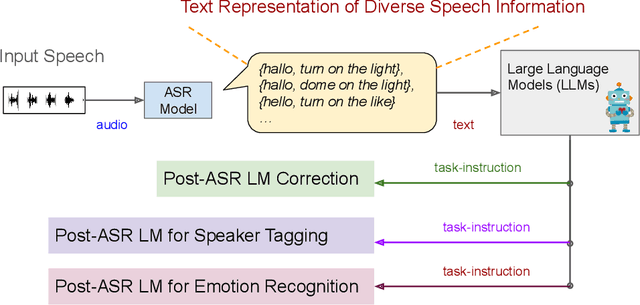
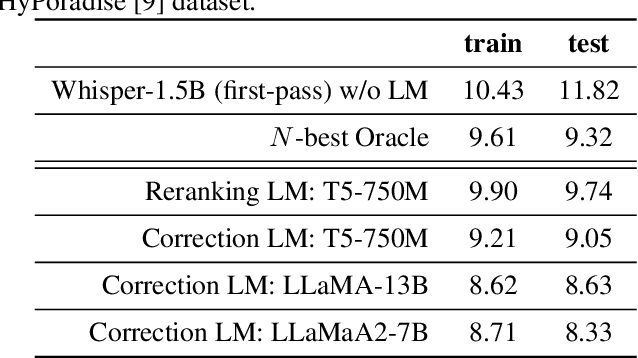
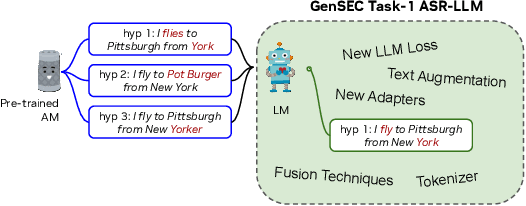
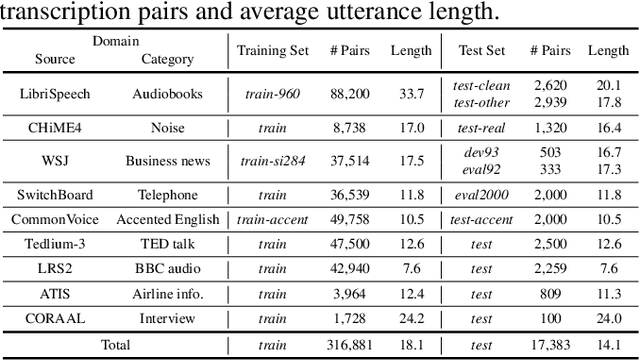
Abstract:Given recent advances in generative AI technology, a key question is how large language models (LLMs) can enhance acoustic modeling tasks using text decoding results from a frozen, pretrained automatic speech recognition (ASR) model. To explore new capabilities in language modeling for speech processing, we introduce the generative speech transcription error correction (GenSEC) challenge. This challenge comprises three post-ASR language modeling tasks: (i) post-ASR transcription correction, (ii) speaker tagging, and (iii) emotion recognition. These tasks aim to emulate future LLM-based agents handling voice-based interfaces while remaining accessible to a broad audience by utilizing open pretrained language models or agent-based APIs. We also discuss insights from baseline evaluations, as well as lessons learned for designing future evaluations.
Sortformer: Seamless Integration of Speaker Diarization and ASR by Bridging Timestamps and Tokens
Sep 10, 2024



Abstract:We propose Sortformer, a novel neural model for speaker diarization, trained with unconventional objectives compared to existing end-to-end diarization models. The permutation problem in speaker diarization has long been regarded as a critical challenge. Most prior end-to-end diarization systems employ permutation invariant loss (PIL), which optimizes for the permutation that yields the lowest error. In contrast, we introduce Sort Loss, which enables a diarization model to autonomously resolve permutation, with or without PIL. We demonstrate that combining Sort Loss and PIL achieves performance competitive with state-of-the-art end-to-end diarization models trained exclusively with PIL. Crucially, we present a streamlined multispeaker ASR architecture that leverages Sortformer as a speaker supervision model, embedding speaker label estimation within the ASR encoder state using a sinusoidal kernel function. This approach resolves the speaker permutation problem through sorted objectives, effectively bridging speaker-label timestamps and speaker tokens. In our experiments, we show that the proposed multispeaker ASR architecture, enhanced with speaker supervision, improves performance via adapter techniques. Code and trained models will be made publicly available via the NVIDIA NeMo framework
Resource-Efficient Adaptation of Speech Foundation Models for Multi-Speaker ASR
Sep 02, 2024
Abstract:Speech foundation models have achieved state-of-the-art (SoTA) performance across various tasks, such as automatic speech recognition (ASR) in hundreds of languages. However, multi-speaker ASR remains a challenging task for these models due to data scarcity and sparsity. In this paper, we present approaches to enable speech foundation models to process and understand multi-speaker speech with limited training data. Specifically, we adapt a speech foundation model for the multi-speaker ASR task using only telephonic data. Remarkably, the adapted model also performs well on meeting data without any fine-tuning, demonstrating the generalization ability of our approach. We conduct several ablation studies to analyze the impact of different parameters and strategies on model performance. Our findings highlight the effectiveness of our methods. Results show that less parameters give better overall cpWER, which, although counter-intuitive, provides insights into adapting speech foundation models for multi-speaker ASR tasks with minimal annotated data.
NEST: Self-supervised Fast Conformer as All-purpose Seasoning to Speech Processing Tasks
Aug 23, 2024



Abstract:Self-supervised learning has been proved to benefit a wide range of speech processing tasks, such as speech recognition/translation, speaker verification and diarization, etc. However, most of these approaches are computationally intensive due to using transformer encoder and lack of sub-sampling. In this paper, we propose a new self-supervised learning model termed as Neural Encoder for Self-supervised Training (NEST). Specifically, we adopt the FastConformer architecture, which has an 8x sub-sampling rate and is faster than Transformer or Conformer architectures. Instead of clustering-based token generation, we resort to fixed random projection for its simplicity and effectiveness. We also propose a generalized noisy speech augmentation that teaches the model to disentangle the main speaker from noise or other speakers. Experiments show that the proposed NEST model improves over existing self-supervised models on a variety of speech processing tasks. Code and checkpoints will be publicly available via NVIDIA NeMo toolkit.
Codec-ASR: Training Performant Automatic Speech Recognition Systems with Discrete Speech Representations
Jul 03, 2024
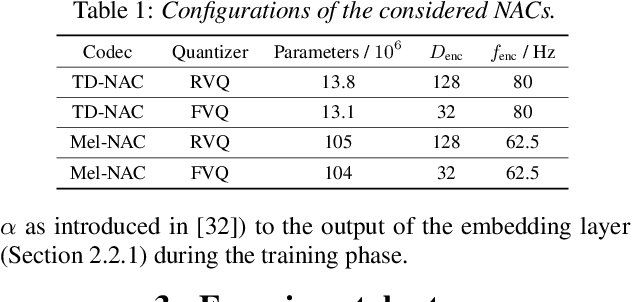

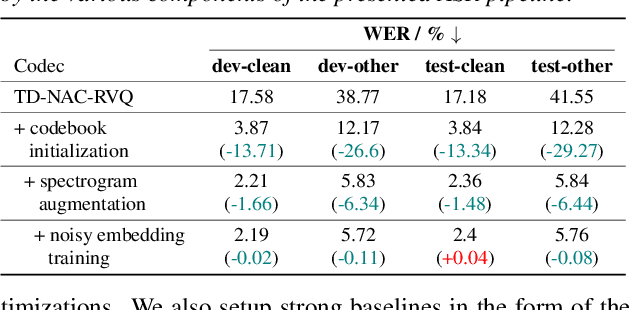
Abstract:Discrete speech representations have garnered recent attention for their efficacy in training transformer-based models for various speech-related tasks such as automatic speech recognition (ASR), translation, speaker verification, and joint speech-text foundational models. In this work, we present a comprehensive analysis on building ASR systems with discrete codes. We investigate different methods for codec training such as quantization schemes and time-domain vs spectral feature encodings. We further explore ASR training techniques aimed at enhancing performance, training efficiency, and noise robustness. Drawing upon our findings, we introduce a codec ASR pipeline that outperforms Encodec at similar bit-rate. Remarkably, it also surpasses the state-of-the-art results achieved by strong self-supervised models on the 143 languages ML-SUPERB benchmark despite being smaller in size and pretrained on significantly less data.
Less is More: Accurate Speech Recognition & Translation without Web-Scale Data
Jun 28, 2024Abstract:Recent advances in speech recognition and translation rely on hundreds of thousands of hours of Internet speech data. We argue that state-of-the art accuracy can be reached without relying on web-scale data. Canary - multilingual ASR and speech translation model, outperforms current state-of-the-art models - Whisper, OWSM, and Seamless-M4T on English, French, Spanish, and German languages, while being trained on an order of magnitude less data than these models. Three key factors enables such data-efficient model: (1) a FastConformer-based attention encoder-decoder architecture (2) training on synthetic data generated with machine translation and (3) advanced training techniques: data-balancing, dynamic data blending, dynamic bucketing and noise-robust fine-tuning. The model, weights, and training code will be open-sourced.
Spectral Codecs: Spectrogram-Based Audio Codecs for High Quality Speech Synthesis
Jun 07, 2024Abstract:Historically, most speech models in machine-learning have used the mel-spectrogram as a speech representation. Recently, discrete audio tokens produced by neural audio codecs have become a popular alternate speech representation for speech synthesis tasks such as text-to-speech (TTS). However, the data distribution produced by such codecs is too complex for some TTS models to predict, hence requiring large autoregressive models to get reasonable quality. Typical audio codecs compress and reconstruct the time-domain audio signal. We propose a spectral codec which compresses the mel-spectrogram and reconstructs the time-domain audio signal. A study of objective audio quality metrics suggests that our spectral codec has comparable perceptual quality to equivalent audio codecs. Furthermore, non-autoregressive TTS models trained with the proposed spectral codec generate audio with significantly higher quality than when trained with mel-spectrograms or audio codecs.
 Add to Chrome
Add to Chrome Add to Firefox
Add to Firefox Add to Edge
Add to Edge